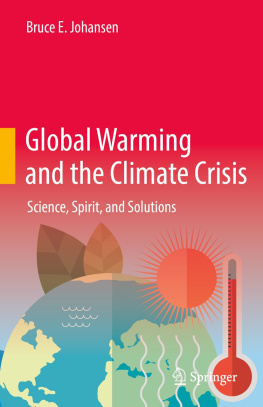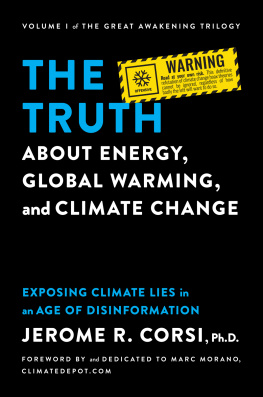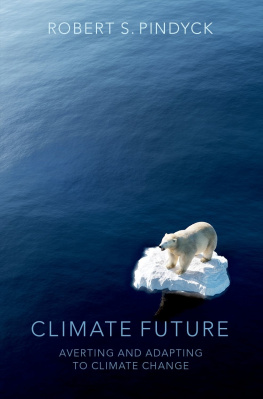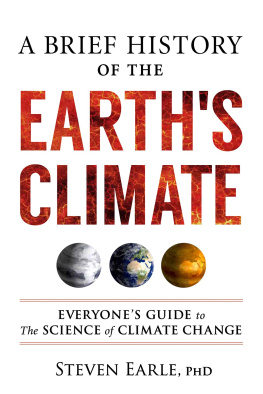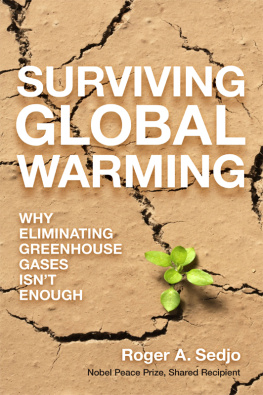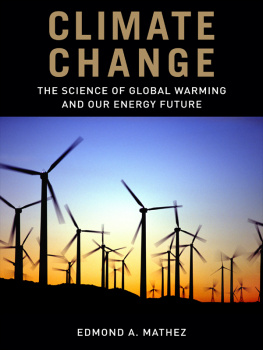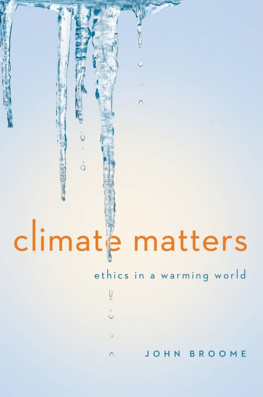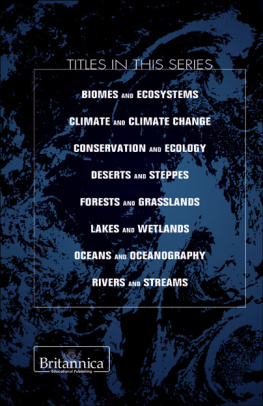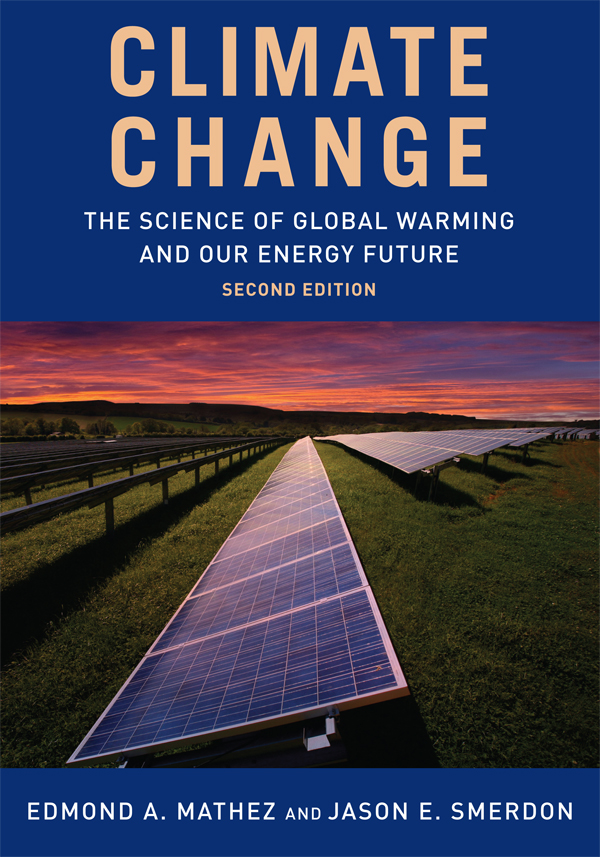Contents
Guide
Pagebreaks of the print version
Climate Change
Climate Change
THE SCIENCE OF GLOBAL WARMING AND OUR ENERGY FUTURE
Second Edition
EDMOND A. MATHEZ and JASON E. SMERDON
COLUMBIA UNIVERSITY PRESS NEW YORK

COLUMBIA UNIVERSITY PRESS
Publishers Since 1893
New York Chichester, West Sussex
cup.columbia.edu
Copyright 2018 Edmond A. Mathez and Jason E. Smerdon
All rights reserved
E-ISBN 978-0-231-54787-1
Library of Congress Cataloging-in-Publication Data
Names: Mathez, Edmond A., author. | Smerdon, Jason E., author.
Title: Climate change : the science of global warming and our energy future / Edmond A. Mathez and Jason E. Smerdon.
Description: Second edition. | New York : Columbia University Press, [2018] | Includes bibliographical references and index.
Identifiers: LCCN 2017054632 | ISBN 9780231172820 (cloth : alk. paper) | ISBN 9780231172837 (pbk. : alk. paper)
Subjects: LCSH: Climatic changes. | Global warming.
Classification: LCC QC981.8.C5 M378 2018 | DDC 551.6dc23
LC record available at https://lccn.loc.gov/2017054632
A Columbia University Press E-book.
CUP would be pleased to hear about your reading experience with this e-book at .
Cover image: Patrick Eden / Alamy
To our children, Sophia and Lucas, and Anas and Emile, and to all the others of their generation who will bear many of the burdens of climate change and who will ultimately be tasked with finding a path to a more sustainable future.
CONTENTS
The genesis of the first edition of Climate Change: The Science of Global Warming and Our Energy Future was a document to support the development of the American Museum of Natural Historys special exhibition Climate Change: Threat to Life and Our Energy Future , which opened in New York City in October 2008 and for which one of us (EAM) served as co-curator. Thus the original book was highly generalized, written, as it was, for a relatively broad audience. Since the time of writing the first edition and through our continued classroom experiences, however, it became apparent that university students need a more substantial introduction to climate science. Thus was born this second edition, which is much expanded from the first. Its target audiences include undergraduate students in beginning to upper-division climate courses, as well as graduate students in nontechnical programs such as education, journalism, and environmental policy. We seek to appeal to this wide university audience with a conceptual focus on the subject matter, avoiding complex mathematical formulations and layering content by consigning detailed or focused arguments to boxes. We hope that this approach will provide instructors with a basis for more in-depth classroom investigation.
This edition also takes on a somewhat more didactic character than the first. Each chapter ends with a roundup called Key Points in This Chapter, in which the chapters salient points are listed. Most chapters also contain a section titled Back-of-the-Envelope Calculation, in which a simple computation illustrates one of the relevant chapter principles. Each Historical Note presents a biographical sketch of a scientist central to the development of climate science, providing the historical context of our present knowledge. Readers should also understand that this book relies mainly on the primary scientific literature. We nevertheless have limited the citations on each subject to a relatively few recent references, the intent being to provide a bibliography that allows the student practical entry into the broader literature. We must emphasize, however, that the narrative is based on an enormous body of work involving thousands of people, not all of whose work is cited. Finally, similar to the first edition, this second edition is a narrative account, written more as a story than in the style of a traditional textbook.
The story of this book sets out the scientific basis for our understanding of climate change. It is divided into four parts, beginning with a description of Earths present climate system. We explain the workings and interactions of the atmosphere and the ocean; how they move heat around the planet and bring us familiar climate phenomena, such as the El NioSouthern Oscillation and the monsoons; and the all-important carbon cycle, which determines the carbon dioxide content of the atmosphere. concerns the consequences of climate change. To appreciate how climate change can affect humanity, we first turn our attention to how humans were affected by climate change over roughly the past 10,000 years. We then describe climate change as it has been observed in the twentieth and twenty-first centuries and its consequences to date.
All this brings us to the future. Computer models of the climate system help us understand how climate may change in the coming decades and centuries. We therefore begin with a description of climate models and their projections of what might come to pass. No one knows what the future will bring, of course, so we devote some effort to casting climate as a matter of risk. To deal with an unknown future, humanity invented the concept of risk, in which cost-benefit analysis provides a basis for rational decision making in the face of uncertainty. We thus apply the concept of risk in the context of adaptation to climate change and attempts at mitigation. Among the many aspects of these efforts, it becomes immediately apparent that of paramount concern is our ability to control emissions from the burning of fossil fuels and to apply alternative technologies to satisfy the worlds insatiable appetite for energy. This appetite is dominated by one overriding issue: how we are going to provide for the worlds electricity needs. Because of its centrality to future climate, we have chosen to focus on this matter in the final chapter of this book, at the same time recognizing that the production of energy is now (and has been) a rapidly changing enterprise.
This book found the support of many people. One of the joys of its writing was how much we learned from each other and from our many colleagues, many of whom are at the Lamont-Doherty Earth Observatory of Columbia University. We are also indebted to Kent Short, Scott Mandia, Dennis Hartmann, Alessandra Grannini, Mingfang Ting, A. Park Williams, and several anonymous reviewers who suffered through early drafts of the manuscript and provided insightful suggestions for its improvement. The content of the book was also strongly influenced by the innovative legacy of climate courses taught at Columbia University, and we are grateful to the instructors who shared their support, insights, and materials over the years. Several colleagues deserve particular mention: Stephanie Pfirman, Jerry McManus, Yochanan Kushnir, Mark Cane, Ben Cook, Linda Sohl, Steve Cohen, and Louise Rosen. JES is also grateful to Henry and Lana Pollack, who inspired his transition into climate science and who remain aspirational examples of effective public communication and outreach. This book also would not have been possible without the unfailing enthusiasm and hard work of our editor, Patrick Fitzgerald, and the technical support of manuscript editor Irene Pavitt and designer Milenda Lee, all of Columbia University Press, and of Saebyul Choe of the American Museum of Natural History. Finally, none of this would have been possible without the inspiration, support, and patience of our families.


